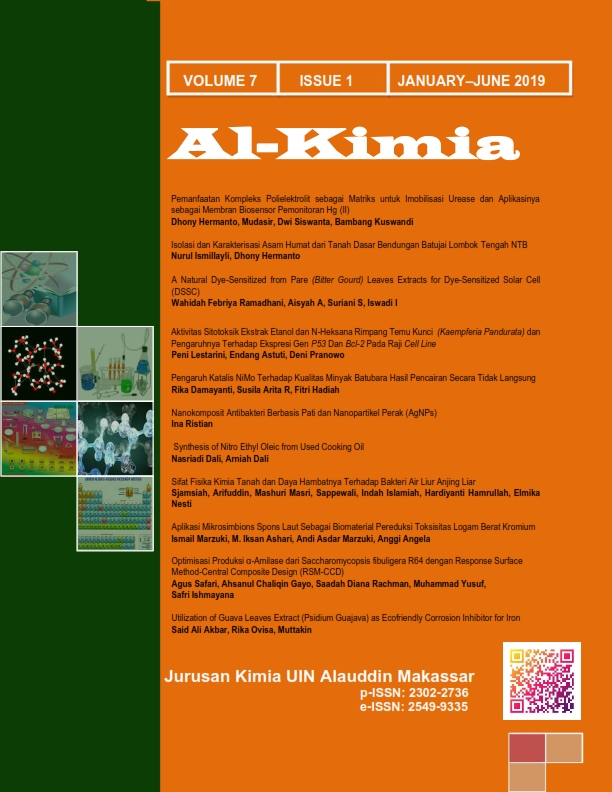Utilization Of Guava Leaves Extract (Psidium Guajava) As Ecofriendly Corrosion Inhibitor For Iron
Abstrak
The use of a green inhibitor from guava leaves extract as an alternative to environmentally friendly metal corrosion inhibitors has been carried out. The guava leaves extracted by 96% ethanol in the maserator for 4 days with occasional shaking and two rejuvenations. The inhibitor performance test was carried out using 2 types of water (wells and sea), as well as variations in extract concentrations of 3%, 10% and 25%. Through phytochemical testing results, it was found that the active secondary metabolite components contained in guava leaves are flavonoids, terpenoids, and tannins. Increasing the concentration of guava leaves extract in well and sea water samples, reducing the value of the corrosion rate. In seawater, the use of 25% leaves extract, there was a weight increase of nails only 0.165% of the initial weight compared with no extract which was 10.75% of the initial weight. Furthermore, the greatest inhibitor efficiency occurred at 25% extract concentration, which was 96.39% in well water media and 97.07% in sea water media. Therefore, guava leaves have the potential to be used as future green inhibitor applications.##plugins.generic.usageStats.downloads##
Referensi
Akbar, S. A., Mardhiah, A., Saidi, N., & Lelifajri, L. (2017). Sintesis Dan Karakterisasi Polianilina (PANI) Dengan Variasi Doping Asam Kuat Menggunakan Metoda Elektrodeposisi, Prosiding Seminar Nasional USM (pp. 557–559). Aceh, Indonesia. DOI: https://ojs.serambimekkah.ac.id/index.php/semnas/article/view/433
Akbar, S. A., Rochliadi, A., Suendo, V., Saidi, N., Lelifajri., & Mardhiah, A. (2018). A Raman Spectroscopy Study Of The Polyaniline Electrode On Zn-Polyaniline Rechargeable Batteries, Rasayan J. Chem, 11(4), 1525-1531. DOI: http://dx.doi.org/10.31788/RJC.2018.1144064
Askari, M., Aliofkhazraei, M., Ghaffari, S., & Hajizadeh, A. (2018). Film former corrosion inhibitors for oil and gas pipelines - A technical review, J Nat Gas Sci Eng, 58, 92-114. DOI: https://doi.org/10.1016/j.jngse.2018.07.025
Chakraborty, S., Afaq, N., Singh, N., & Majumdar, S. (2018). Antimicrobial activity of Cannabis sativa, Thuja orientalis and Psidium guajava leaves extracts against methicillin-resistant Staphylococcus aureus, J. Integr. Med, 16(5), 350-357. DOI: https://doi.org/10.1016/j.joim.2018.07.005
Haruna, K., Obot, I. B., Ankah, N. K., Sorour, A. A., & Saleh, T. A. (2018). Gelatin: A green corrosion inhibitor for carbon steel in oil well acidizing environment, J Mol Liq, 264, 515-525. DOI: https://doi.org/10.1016/j.molliq.2018.05.058
Hu, W., Li, C., & Shchukin, D. G. (2018). Ceramic honeycomb-like alumina film as corrosion inhibitor carrier and mechanism analysis, Colloids Surf. A, 555, 237-245. DOI: https://doi.org/10.1016/j.colsurfa.2018.06.071
Mahidashti, Z., Shahrabi, T., & Ramezanzadeh, B. (2018). The role of post-treatment of an ecofriendly cerium nanostructure Conversion coating by green corrosion inhibitor on the adhesion and corrosion protection properties of the epoxy coating, Prog Org Coat, 114, 19-32. DOI: https://doi.org/10.1016/j.porgcoat.2017.09.015
Mo, S., Li, L. J., Luo, H, Q., & Li, N. B. (2017). An example of green copper corrosion inhibitors derived from flavor and medicine: Vanillin and isoniazid, J Mol Liq, 242, 822-830. DOI: https://doi.org/10.1016/j.molliq.2017.07.081
Moradi, M., Song, Z., & Xiao, T. (2018). Exopolysaccharide produced by Vibrio neocaledonicus sp. as a green corrosion inhibitor: Production and structural characterization, Mater Sci Technol, 34, 2447-2457. DOI: https://doi.org/10.1016/j.jmst.2018.05.019
Rassouli, L., Naderi, R., & Mahdavain, M. (2018). Study of the impact of sequence of corrosion inhibitor doping in zeolite on the self-healing properties of silane sol–gel film, Ind. Eng. Chem. Res, 66, 221-230. DOI: https://doi.org/10.1016/j.jiec.2018.05.033
Rochliadi, A., Akbar, S. A., & Suendo, V. (2015). Polyaniline/Zn as secondary battery for electric vehicle base on energy return factor, Proceedings of the Joint International Conference on Electric Vehicular Technology and Industrial, Mechanical, Electrical and Chemical Engineering (ICEVT & IMECE) (pp. 353–358). Surakarta, Indonesia. DOI: https://doi.org/10.1109/ICEVTIMECE.2015.7496686
Saviour, A., Umoren., Abdullah, A., Ahmary, A., Gasem, Z. M., & Solomon, M. M. (2018). Evaluation of chitosan and carboxymethyl cellulose as ecofriendly corrosion inhibitors for steel. Int. J. Biol. Macromol, 117, 1017-1028. DOI: https://doi.org/10.1016/j.ijbiomac.2018.06.014
Verma, C., Ebenso, E. E., Bahadur I., & Quraishi, M. A. (2018). An overview on plant extracts as environmental sustainable and green corrosion inhibitors for metals and alloys in aggressive corrosive media, J Mol Liq, 266, 577-590. DOI: https://doi.org/10.1016/j.molliq.2017.02.111
Wang, L., Lu, F., Liu, Y., Wu, Y., & Wu, Z. (2018). Photocatalytic degradation of organic dyes and antimicrobial activity of silver nanoparticles fast synthesized by flavonoids fraction of Psidium guajava L. leaves, J Mol Liq, 263, 187-192. DOI: https://doi.org/10.1016/j.molliq.2018.04.151
Wysocka, J., Cieslik, M., Krakowiak, S., & Ryl, J. (2018). Carboxylic acids as efficient corrosion inhibitors of aluminium alloys in alkaline media, Electrochim. Acta, 289, 175-192. DOI: https://doi.org/10.1016/j.electacta.2018.08.070
##submission.copyrightStatement##
##submission.license.cc.by-nc-sa4.footer##Authors who publish with this journal agree to the following terms:
1) Authors retain copyright and grant the journal right of first publication with the work simultaneously licensed under a Creative Commons Attribution License that allows others to share the work with an acknowledgement of the work's authorship and initial publication in this journal.
2) Authors are able to enter into separate, additional contractual arrangements for the non-exclusive distribution of the journal's published version of the work (e.g., post it to an institutional repository or publish it in a book), with an acknowledgement of its initial publication in this journal.
3)Authors are permitted and encouraged to post their work online (e.g., in institutional repositories or on their website) prior to and during the submission process, as it can lead to productive exchanges, as well as earlier and greater citation of published work (See The Effect of Open Access).


